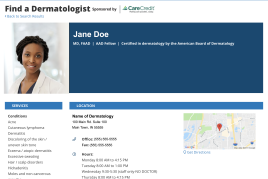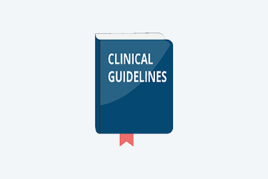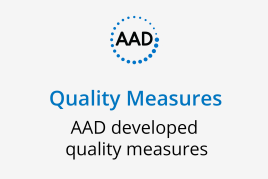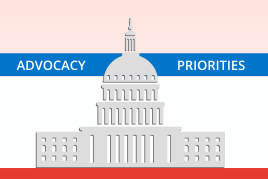Sunscreen FAQs
Sun Protection Resource Center
Looking for information on sunscreen? Visit the Academy's Sun Protection Resource Center.
Learn moreSeeking shade, wearing protective clothing — including a lightweight and long-sleeved shirt, pants, a wide-brimmed hat, and sunglasses with UV protection — and using sunscreen are all important behaviors to reduce your risk of skin cancer. Sunscreen products are regulated as over-the-counter drugs by the U.S. Food and Drug Administration (FDA).
Scientific evidence supports the benefits of using sunscreen to minimize short-term and long-term damage to the skin from the sun’s rays. Claims that sunscreen ingredients are a hazard to human health have not been proven.
Who needs sunscreen?
Everyone. Sunscreen use can help prevent skin cancer by protecting you from the sun’s harmful ultraviolet (UV) rays. Anyone can get skin cancer, regardless of age, gender or race. In fact, it is estimated that one in five Americans will develop skin cancer in their lifetime.1 Sunscreen can also help prevent premature skin aging, such as wrinkles and age spots, caused by too much unprotected UV exposure. 2,3
What sunscreen should I use?
The American Academy of Dermatology recommends that everyone use sunscreen that offers the following:
Broad-spectrum protection (protects against UVA and UVB rays)
SPF 30 or higher
Water resistance
A sunscreen that offers the above helps to protect your skin from sunburn, early skin aging3 and skin cancer. However, sunscreen alone cannot fully protect you. In addition to wearing sunscreen, dermatologists recommend taking the following steps to protect your skin and detect skin cancer early, when it’s most treatable:
Seek shade when appropriate, remembering that the sun’s rays are strongest between 10 a.m. and 2 p.m. If your shadow is shorter than you are, seek shade.4
Dress to protect yourself from the sun by wearing a lightweight and long-sleeved shirt, pants, a wide-brimmed hat, and sunglasses with UV protection, when possible. For more effective sun protection, select clothing with an ultraviolet protection factor (UPF) number on the label.
Use extra caution near water, snow, and sand as they reflect the damaging rays of the sun, which can increase your chance of sunburn.
Get vitamin D safely through a healthy diet that may include vitamin supplements. Don’t seek the sun.5
Avoid tanning beds. Ultraviolet light from the sun and tanning beds can cause skin cancer and wrinkling.3,6 If you want to look tan, you may wish to use a self-tanning product, but continue to use sunscreen with it.
Check your birthday suit on your birthday. If you notice anything changing, itching or bleeding on your skin, see a board-certified dermatologist. Skin cancer is highly treatable when caught early.
When should I use sunscreen?
Every day if you will be outside. The sun emits harmful UV rays year-round. Even on cloudy days, up to 80% of the sun’s harmful UV rays can penetrate the clouds.7
Be extra mindful about applying sunscreen around snow, sand, and water, as these surfaces reflect the sun’s rays, increasing your chance of sunburn.7
How much sunscreen should I use, and how often should I apply it?
Most people only apply about 20–50% of the amount of sunscreen needed to achieve the amount of SPF on the label.8
Apply enough sunscreen to cover all exposed skin. Most adults need about 1 ounce — or enough to fill a shot glass — to fully cover their entire body.
Don't forget to apply to the tops of your feet, your neck, your ears and the top of your head.
Apply sunscreen to dry skin 15 minutes before going outdoors.
Skin cancer also can form on the lips. To protect your lips, apply a lip balm or lipstick that contains sunscreen with an SPF of 30 or higher.
When outdoors, reapply sunscreen approximately every two hours, or after swimming or sweating, according to the directions on the bottle.
Broad-spectrum sunscreens protect against both UVA and UVB rays. What is the difference between the rays?
Sunlight consists of two types of harmful rays that reach the earth — UVA rays and UVB rays. Overexposure to either can lead to skin cancer. In addition to causing skin cancer, here’s what each of these rays do:
UVA rays (or aging rays) can prematurely age your skin, causing wrinkles and age spots, and can pass through window glass.
UVB rays (or burning rays) are the primary cause of sunburn and are blocked by window glass.
The United States Department of Health & Human Services and the World Health Organization’s International Agency of Research on Cancer have declared UV radiation from the sun and artificial sources, such as tanning beds and sun lamps, a known carcinogen (cancer-causing substance).9
There is no safe way to tan. Every time you tan, you damage your skin. As this damage builds, you speed up the aging of your skin and increase your risk for all types of skin cancer.
What is visible light and do I need to protect my skin against it?
Visible light is defined as any light that the human eye can see — from nature’s sunlight to artificial light sources from ceiling lights, our phones, computer screens and TVs. Research shows visible light from the sun can cause skin darkening in dark skinned, but not in light skinned individuals.10 To protect against the negative effects of visible light from the sun, use a broad-spectrum sunscreen that says “tinted” on the label and has an SPF of 30 or higher.11
What type of sunscreen should I use?
The best type of sunscreen is the one you will use again and again. Just make sure it offers broad-spectrum (UVA and UVB) protection, has an SPF of 30 or higher, and is water-resistant.
The kind of sunscreen you use is a matter of personal choice and may vary depending on the area of the body to be protected. Available sunscreen options include lotions, creams, gels, ointments, wax sticks, and sprays.
Creams are best for dry skin and for the face.
Gels are good for hairy areas, such as the scalp or male chest.
Sticks are good to use around the eyes.
Sprays are sometimes preferred by parents since they are easy to apply to children.
However, the challenge in using sprays is that it is difficult to know if you have used enough sunscreen to cover all sun-exposed areas of the body, which may result in inadequate coverage. When using spray sunscreen, spray until your or your child’s skin glistens, and rub it in afterwards to ensure even coverage. Do not inhale these products or apply near heat, open flame or while smoking. To avoid inhaling spray sunscreen, never spray it around or near the face or mouth. Spray the sunscreen into your hands and then use your hands to apply it on your face. When applying spray sunscreens on children, be aware of the direction of the wind to avoid inhalation.Tinted sunscreens, which contain the active ingredients zinc oxide and/or titanium dioxide, can help reduce the white “residue” that can be left on the skin and can help prevent skin darkening that may occur from exposure to visible light from the sun, particularly in dark-skinned individuals.
Some sunscreen products are also available in combination with moisturizers and cosmetics. However, while these products are convenient, remember that sunscreen needs to be reapplied every two hours when you’re outdoors.
Sunscreen may also be sold in combination with an insect repellent. The AAD recommends purchasing and using these products separately, as sunscreen needs to be applied generously and often, whereas insect repellent should be used sparingly and much less frequently.
In addition, keep in mind that while some sunscreens are water resistant, no sunscreen is “waterproof” or “sweatproof.” Sunscreen manufacturers are banned from using these terms, as they would be misleading. Even after using a water-resistant sunscreen, you should reapply it after swimming or sweating.
Regardless of which sunscreen you choose, be sure to apply it generously to achieve the UV protection indicated on the product label.
What is the difference between chemical and physical sunscreens?
Chemical sunscreens work like a sponge, absorbing the sun’s rays. They contain one or more of the following active ingredients: oxybenzone, avobenzone, octisalate, octocrylene, homosalate, and octinoxate. These formulations tend to be easier to rub into the skin without leaving a white residue.
Physical sunscreens work like a shield, sitting on the surface of your skin and deflecting the sun’s rays. They contain the active ingredients zinc oxide and/or titanium dioxide. Opt for this sunscreen if you have sensitive skin. However, they are more likely to leave a white “residue” on the skin unless you use a sunscreen that says “tinted” on the label.
If you are concerned about certain sunscreen ingredients, you can select a formula that contains different active ingredients. As long as your sunscreen is broad-spectrum, water-resistant and has an SPF 30 or higher, it can effectively protect you from the sun.
Is a high-number SPF better than a low-number one?
Dermatologists recommend using a sunscreen with an SPF of at least 30, which blocks 97% of the sun's UVB rays. Higher-number SPFs block slightly more of the sun's UVB rays, but no sunscreen can block 100% of the sun's UVB rays.
It is also important to remember that high-number SPFs last the same amount of time as low-number SPFs. A high-number SPF does not allow you to spend additional time outdoors without reapplication. Sunscreens should be reapplied approximately every two hours when outdoors, even on cloudy days, and after swimming or sweating, according to the directions on the bottle.
How can I protect my baby or toddler from the sun?
Ideally, parents should avoid exposing babies younger than 6 months to the sun’s rays.
The best way to protect infants from the sun is to keep them in the shade as much as possible, in addition to dressing them in long sleeves, pants, a wide-brimmed hat, and sunglasses. If you can’t find shade, create your own using an umbrella, canopy, or the hood of a stroller. Make sure they do not get overheated and that they drink plenty of fluids. If your baby is fussy, crying excessively, or has redness on any exposed skin, take him or her indoors.
Minimize sunscreen use on children younger than six months old. However, if shade and adequate clothing are not available, parents and caretakers may apply a broad-spectrum, water-resistant sunscreen with an SPF of 30 or higher to all skin not covered by clothing, according to the instructions on the product label. When outdoors, sunscreen should be reapplied approximately every two hours, or as often as the label says. Sunscreens that use the ingredients zinc oxide or titanium dioxide, or special sunscreens made for infants or toddlers, may cause less irritation to their sensitive skin.10
Can I use the sunscreen I bought last summer, or do I need to purchase a new bottle each year? Does it lose its strength?
Dermatologists recommend using sunscreen every day when you are outside, not just during the summer. If you are using sunscreen every day and in the correct amount, a bottle should not last long. If you find a bottle of sunscreen that you have not used for some time, here are some guidelines you can follow:
The FDA requires that all sunscreens retain their original strength for at least three years.
Some sunscreens include an expiration date. If the expiration date has passed, throw out the sunscreen.
If you buy a sunscreen that does not have an expiration date, write the date you bought the sunscreen on the bottle. That way, you’ll know when to throw it out.
You also can look for visible signs that the sunscreen may no longer be good. Any obvious changes in the color or consistency of the product mean it’s time to purchase a new bottle.
Will using sunscreen limit the amount of vitamin D I get?
No, studies show that regular use of sunscreen is unlikely to decrease your skin’s production of vitamin D. Because the amount of vitamin D a person receives from the sun is inconsistent and increases the risk of skin cancer, the AAD recommends getting vitamin D from a healthy diet that includes foods naturally rich in vitamin D, foods and beverages fortified with vitamin D, and/or vitamin D supplements.
If you are concerned that you are not getting enough vitamin D, you should discuss your options for getting vitamin D with your doctor.
For more information on vitamin D and UV exposure, check out the AAD’s vitamin D fact sheet.
Are sunscreens safe?
Skin cancer is the most common cancer in the U.S., and unprotected exposure to the sun’s harmful ultraviolet rays is a major risk factor for skin cancer. Scientific evidence supports the benefits of using sunscreen to minimize short-term and long-term damage to the skin from UV. Claims that sunscreen ingredients are toxic or a hazard to human health have not been proven.
Because dermatologists see first-hand the impact that skin cancer has on patients and their families, the AAD recommends that everyone seek shade, wear protective clothing — including a lightweight and long-sleeved shirt, pants, a wide-brimmed hat, and sunglasses with UV protection — and apply a broad-spectrum sunscreen with an SPF of 30 or higher to all skin not covered by clothing. These recommendations are based on current scientific evidence — which shows sunscreen is an effective way to reduce skin cancer risk — and current FDA regulations.
There are two types of sunscreens available — chemical and physical. Both protect you from the sun, but in different ways:
Chemical sunscreens work like a sponge, absorbing the sun’s rays. They contain one or more of the following active ingredients: avobenzone, ensulizole, homosalate, octinoxate, octisalate, octocrylene, or oxybenzone.
Physical sunscreens, also known as mineral sunscreens, act like a shield. They sit on the surface of the skin, primarily deflecting the sun’s rays. They include the active ingredients titanium dioxide and/or zinc oxide and are recommended for people with sensitive skin.
In 2019, the FDA announced that it will reevaluate the safety of every ingredient used in chemical sunscreens to determine whether its absorption into the bloodstream has any effects on a person’s health. (Just because an ingredient is absorbed into the bloodstream does not mean that it is harmful or unsafe). The FDA continues to advise consumers to use sunscreen to protect themselves from the sun’s dangerous UV rays.
The AAD remains committed to supporting and enhancing patient care. If you are concerned about the safety of the ingredients in your sunscreen, speak with a board-certified dermatologist to develop a sun-protection plan that works for you.
How do I treat a sunburn?
It’s important to begin treating a sunburn as soon as possible. In addition to stopping further UV exposure, dermatologists recommend treating a sunburn with:
Cool baths to reduce the heat.
Moisturizer to help ease the discomfort caused by dryness. As soon as you get out of the bathtub, gently pat yourself dry, but leave a little water on your skin. Then apply a moisturizer to trap the water in your skin.
Hydrocortisone cream that you can buy without a prescription to help ease discomfort.
Aspirin or ibuprofen. This can help reduce the swelling, redness, and discomfort.
Drinking extra water. A sunburn draws fluid to the skin surface and away from the rest of the body. Drinking extra water prevents dehydration.
Do not treat sunburns with “-caine” products (such as benzocaine).
If your skin blisters, you have a second-degree sunburn. Dermatologists recommend that you:
Allow the blisters to heal untouched. Blisters form to help your skin heal and protect you from infection.
If the blisters cover a large area, such as the back, or you have chills, a headache or a fever, seek immediate medical care.
With any sunburn, you should avoid the sun while your skin heals. Be sure to cover the sunburn every time you head outdoors.
1Stern RS. Prevalence of a history of skin cancer in 2007: results of an incidence-based model. Arch Dermatol. 2010 Mar;146(3):279-82.
2Food and Drug Administration. Sunscreen: How to Help Protect Your Skin from the Sun. Accessed February 10, 2021.
3Hughes MC, Williams GC, Baker P, Green AC; Sunscreen and Prevention of Skin Aging, a Randomized Trial. Annals of Internal Medicine. 2013; 158(11):781-790.
4Holloway L. Atmospheric sun protection factor on clear days: its observed dependence on solar zenith angle and its relevance to the shadow rule for sun protection. Photochem Photobiol 1992;56:229-34.
5American Academy of Dermatology. Position Statement on Vitamin D. 2010, December 22.
6IARC Monographs on the Evaluation of Carcinogenic Risks to Humans, No. 100D. IARC Working Group on the Evaluation of Carcinogenic Risks to Humans. Lyon (FR): International Agency for Research on Cancer; 2012.
7Global Solar UV Index. World Health Organization.
8Petersen B, Wulf HC. Application of sunscreen− theory and reality. Photodermatology, photoimmunology & photomedicine. 2014 Apr;30(2-3):96-101.
9NTP (National Toxicology Program). 2016. Report on Carcinogens, Fourteenth Edition.; Research Triangle Park, NC: U.S. Department of Health and Human Services, Public Health Service.
10Paller, AS et al. New Insights About Infant and Toddler Skin: Implications for Sun Protection. Pediatrics. 2011 July; 128 (1): 92-102.
11Lyons AB, Trullas C, Kohli I, Hamzavi IH, Lim HW. Photoprotection beyond ultraviolet radiation: A review of tinted sunscreens. J Am Acad Dermatol. 2020 April; 84.
12Geisler A, Austin E, Nguyen J. Hamzavi I, Jagdeo J, Lim HW. Visible light. Photoprotection against visible and ultraviolet light. J Am Acad Dermatol. 2021 May;84(5):1393-1397. doi: 10.1016/j.jaad.2020.04.079. Epub 2020 Apr 23.
 Make it easy for patients to find you.
Make it easy for patients to find you.
 Meet the new AAD
Meet the new AAD
 2022 AAD VMX
2022 AAD VMX
 AAD Learning Center
AAD Learning Center
 Need coding help?
Need coding help?
 Reduce burdens
Reduce burdens
 Clinical guidelines
Clinical guidelines
 Why use AAD measures?
Why use AAD measures?
 Latest news
Latest news
 New insights
New insights
 Combat burnout
Combat burnout
 Joining or selling a practice?
Joining or selling a practice?
 Advocacy priorities
Advocacy priorities
 Promote the specialty
Promote the specialty
